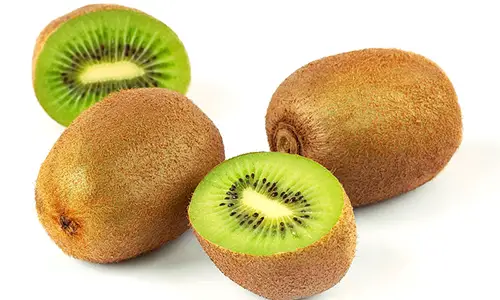The kiwi fruit is a fruit that graces the tables of hotels, restaurants and households the world over. This unusual looking little fruit is full of taste and nutrition, an exotic addition to fruit salads and breakfast cereals. It has travelled from its native China to be cultivated in orchards in Europe and America.
FACT 1: The kiwi fruit is small, about 3 inches long and weighing about 50 g. It is egg shaped with a furry brownish green skin. It has a firm green flesh, with purple, black edible little seeds. Kiwifruit have a slightly acid taste with a streak of sweetness. It can be eaten raw or cooked and the juice is sometimes used as a meat tenderiser.
FACT 2: The fruit is endemic to China and Taiwan. It is now grown extensively on a commercial basis in California and New Zealand. It is also grown in Italy, Chile, France and Japan. The chief exporters California and New Zealand lie in different side of the Equator, making the fruit available all the year round. The New Zealand variety is available from June to October and the Californian variety from November to May.
FACT 3: The kiwi fruit is an antioxidant. It is rich in many well- known vitamins and minerals including Vitamin C and the mineral potassium. In addition it contains phytonutrients that protect the DNA in the nucleus of a cell, from oxygen related damage.
FACT 4: Kiwi fruit are rich in vitamin C. They contain more of the vitamin than an orange. The fruit is recommended for the healthy functioning of the immune system. It is known to reduce the severity of osteoarthritis and rheumatoid arthritis. It is also known to prevent respiratory-related health problems.
FACT 5: The kiwi fruit is rich in dietary fibre. It is known to reduce cholesterol levels, remove toxins from the colon and keep blood sugar levels low.
FACT 6: Kiwi fruit is as or even more highly recommended for good eyesight, than carrots. Taken three times a day, kiwifruit is a protection against vision destroying diseases.
FACT 7: In China the kiwi fruit was called the Yang Tao. In the early 20th century missionaries carried the fruit to New Zealand. In 1960, as the taste resembled that of gooseberries, the Yang Tao was renamed the Chinese gooseberry. In 1961, an American restaurant served kiwi. A produce distributor recognizing its potential, arranged to import the fruit from New Zealand in 1962. It was renamed the kiwi fruit after the New Zealand bird kiwi, as its outer skin resembles the feathers of the kiwi.
FACT 8: A kiwifruit that has reached the peak of its sweetness will yield gently when pressure is applied on the outer surface. Very soft or shrivelled fruit should be avoided. If the fruit is a little hard and does not yield to pressure, then it can be left to ripen for a few days at room temperature, away from direct sunlight and heat. The ripening process can be speeded up by placing the kiwi fruit in a paper bag with a banana, apple or pear.
FACT 9: Kiwi fruit can be peeled and eaten. However the skin is thin, sweet and very edible. The peach like fuzz can be rubbed off.
FACT 10: The enzymes (actinic and bromic acids) contained I n a kiwi fruit act as food tenderisers. This means that if the fruit must be peeled immediately before eating, or else it will get too soft. If added to a fruit salad too early, it will tenderise the other fruit.











Leave a Reply